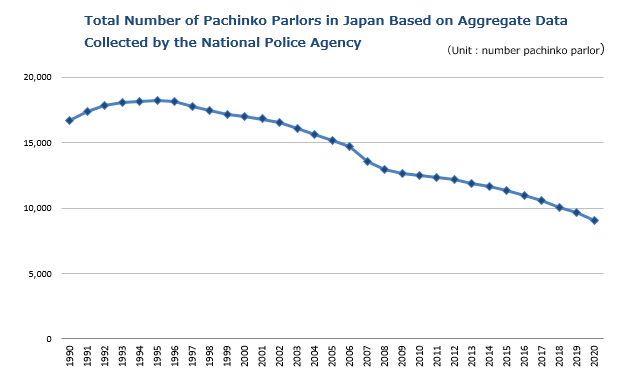According to aggregate data collected by the National Police Agency, the total number of pachinko parlors in Japan was 9,035 as of the end of 2020. It had decreased for 25 consecutive years since 1995 when it reached its peak (18,244).
After the Second World War, the total number of pachinko parlors in Japan increased as the Japanese economy continued to recover. It exceeded 45,000 around 1945 to 1954. However, the ban against the use of renpatsu-shiki (rapid-shot) pachinko machines, which was highly speculative, was issued, which also made the number of pachinko parlors plunge. The number declined to as low as about 8,800 pachinko parlors by around 1955. Since then, it had remained around 10,000 for years. Around 1980, the Fever pachinko machine made its debut and substantially changed the pachinko market. This was the so-called “Fever Boom”. Thereafter, the number of pachinko parlors began to increase by 400 to 500 each year.
Around 1995, however, the pachinko industry faced hardships such as the rampant use of altered prepaid cards and other social problems resulting from pachinko addiction. Since then, the number of pachinko parlors has been declining. However, this is partly because pachinko parlors have grown in size while the total number of gaming machines in Japan has remained unchanged.
In other words, the pachinko industry is experiencing a “polarizing” situation, in which companies running multiple pachinko parlors open multiple large scale establishments, while medium and small scale establishments go out of business. We would say the pachinko industry’s business confidence cannot be determined solely by increases/decreases in the number of pachinko parlors.

Recent trends in the pachinko player population clearly show the difficult conditions the pachinko industry is experiencing. According to the Japan Productivity Center’s White Paper on Leisure, the number of pachinko players was 7.1 million in 2020.
From 1975 until 1995, it ranged from 28 million to 29 million while pachinko parlors were on the rise. During this period, the number of pachinko players was thought to be about 30 million. However, it should be noted that this number includes people that played pachinko at least once a year. In a strict sense, it should not be defined as pachinko population.
However, there is no doubt about the sharp drop in the pachinko population of 30 million since about 1996. It decreased to 20 million in 1998 and it fell below 15 million in 2007. The pachinko industry is shocked by the recent trend under which the number has remained below 10 million people. Restructuring the attractiveness of pachinko parlors and pachislo in recent times of increasingly diversified leisure options is one of our most urgent issues.